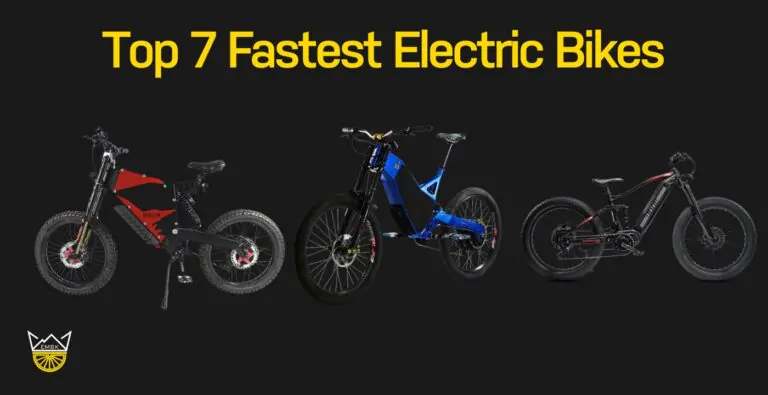
A love for speed, adrenaline and the outdoors has brought many great minds into the world of mountain biking, and, as a result, our collective understanding of the engineering behind the sport has created so many different variations in the ways you can ride. Though this can make selecting the right e-mountain bike tyres a challenge, we promise you, it’s worth it.
In general, as an electric mountain bike weighs between 15-28kg, which is far heavier than a normal MTB averaging 13.2kg the wheels need to be able to put up with a lot of force. For this reason, the front tyre typically needs to be 29″ and the back needs to be 27.5″. This allows them to put up with the force and torque which can often reach levels of 80-85 newton-metres.
However, there are many different factors to consider and these wheel sizes aren’t necessarily the suggested size for all terrains and riders. Read on, to find out everything you should consider, to make the right choice for your electric mountain bike adventures.
E-MTB Tyre Size Regulations
In the US, e-bikes are largely unrestricted, meaning you can put whatever wheels you want on them. In Europe, on the other hand, there are restrictions that subject wheels to the same rigour as moped wheels, so unless a wheel meets ECE-R75 endurance standards, it’s not going to be road legal.
The reason behind this is that electric bike wheels are subject to much higher forces, and so must be rated to withstand these with ease, whether that’s on a trail or the pavement. So whichever tyres you end up considering, make sure they’re compliant with those regulations.
Despite these regulations, we still get some choice between which wheels we use, and the effects that these choices have on the ride can be incredibly significant, so to help you get to grips with them, we’ll start by describing some of the main variations.
Main Variations in Wheel Choice
The main differences from wheel to wheel will fall into one of these four categories:
- Size
- Rim type
- Thickness
- Width
How Does e-Mountain Bike Tyre Size Affect Riding?
As we alluded to just before, mountain bike tyre sizes are amongst the most common variations you can get with an MTB. As you can probably guess, a larger wheel comes with more weight. Since e-bikes are already significantly heavier than normal bikes, their total weight is affected proportionally less by the wheel weight, but that doesn’t mean it’s a factor you should ignore. That’s because wheel weight still affects acceleration; the heavier the wheel, the slower the acceleration.
This goes for the reverse too. Larger mtb tyre sizes decelerate more slowly, which leads to less reactive riding, but they are more stable, and therefore more suited to long rides than trick trails where more agility is preferable.
So, if larger wheels accelerate more slowly, why are 29-inch wheels so popular these days? Well, one of the main benefits is that they fare much better on rough terrain. It makes perfect sense if you think about it; the bigger the wheel, the less proportional each bump or dip is. So, if you’re not going to be riding pristine trails all the time, then it’s worth thinking about larger tyres.
What Are the Different Types of Wheel Rims?

If you’re already familiar with the mountain biking world then you’ll no doubt have heard the term tubeless being thrown around as a selling point. But what does that actually mean?
Standard bike wheels have an inner tube which is filled with air to give the rubber tread the tension it needs to grip the ground and react to deviations, bumps and dips. Tubeless wheels on the other hand forego the need for a tube by sealing the rubber tyres in a way that allows them to be filled with air, effectively taking another element out of the equation.
And just why would you want this? The answer is that it results in a much higher performance through its increased grip, decreased rolling resistance and puncture resistance. These wheels do come at some extra cost though, and are mostly used by specialists.
Tubeless wheels are more expensive initially, require more servicing, and the setups are a bit more complex. Still, if you were looking for an edge on your bike, they’re more than worth looking into. Riders in Europe are likely to struggle to find eMTBs with tubeless wheels due to wheel regulations, so this niche is more for our American readers.
How Does E-MTB Tyre Width Affect the Ride?

Tire width can sometimes sneak under the radar, but in the search for the perfect ride, it’s a factor that certainly shouldn’t be overlooked. Most e-mountain bike wheels on the market are between 2-3 inches, but there are niche options going as low as 1.5 inches and as large as 4 inches. As you can probably guess, these differences in width are going to affect mass, and therefore acceleration, just like the diameter of wheels.
Thinner wheels are more suitable for aggressive riders, trading a wider grip for more agility. Fat tired wheels, on the other hand, are much more capable of riding on slippery terrain, like sand or snow, due to the gripping power of the increased surface area.
It’s worth noting that you don’t always have to change an entire wheel to get the effect of varied tire width, but you’ll want to look at a size guide for your wheel’s rim size. A rim width of 21-23mm will work well with 2-2.25 inch tyres, whereas if you have 30-35mm rims, then you should be looking at tyres between 2.5-3 inches.
Which Mountain Bike Wheels Should I Have For Different Terrains?
As we just mentioned, wider tyres are much grippier, so if you’re planning on a trip to Lapland or anywhere with poor conditions (sandy, wet, etc..), then it’s wise to grab yourself the widest tyres that your rims can handle.
This advice also applies to downhill rides, which is why you’ll see wheels marketed for downhill riding that sport larger rims and wider tyres. Conversely, some riders who focus on rocky trails swear by narrow or mid-thickness wheels because of their smoother manoeuvring, which makes for easier obstacle navigation.
Frequently Asked Questions (FAQs)
What is the Angle of Attack for Bike Wheels?
The angle of attack is an essential part of the mechanics of how a wheel reacts to a discrepancy in its path, like a large rock. It’s essentially derived from a calculation involving the size of the wheel and the size of the obstacle. A larger wheel is going to have a better angle of attack than a smaller wheel, because of the size ratio, which is why larger wheels are more stable on uneven ground.
Do Electric Bikes Need Different Wheels?
Some types of e-bikes need special wheels for hub-mounted motors, but in the electric mountain bike market, almost all models are mid-driven, making them compatible with most standard mountain bike wheels. Because of European regulations, e-bike wheels must be tested to a higher grade, but don’t worry, these are still the same type of mountain bike wheels you’ll be used to, and specifications like wider wheels or tubeless designs are possible.
What is the Best e-Mountain Bike Tyre for Pavement?
The general consensus is that smaller wheels and thinner tyres are more suitable for pavements because the benefits of larger wheels and thicker tyres are much less important on the uniformity of pavement than on a slippery mountain trail. But most riders are more concerned with off-road performance, so e-bikes with hybrid designs aren’t too common.
Overview
Hopefully, having read this, you’ll have a better understanding of what tyre is right for your e-mountain bike, taking into consideration size, rim type, thickness and width. The type of terrain upon which you ride, and the style of trails you take on, will help inform the tyres you choose.
Generally, though, the power from an e-bike can really help to nullify some of the problems that come from wheel weight, so you can get a ride that’s both stable and powerful. It might be a little easier for Americans to find the right wheel, but it’s by no means a herculean task for a European to get a little bit custom with their bike. And no matter where you’re from, there’ll be tyre options out there for you.



